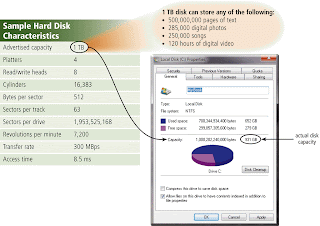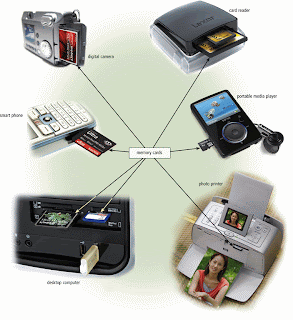- Storage holds data, instructions, and information for future use. For example, all types of users store digitals photos; appoinments, schedules, and contact/address information; correspondence, such as letters, e-mail massages; tax records; Web Pages. A home user also might store budgets, bank statements, a household inventory, records of stock purchases, tax information, homework assignments, recipes, music, and videos.
A storage medium (media is the plural),
also called secondary storage, is
the physical material on which a computer keeps data, instructions, and
information. Examples of storage media are hard disks, solid state drives,
memory cards, USB flash drives, ExpressCard modules, optical discs, smart cards,
magnetic stripe cards, and microfilm. Cloud storage is another storage option,
in which the actual storage media used
is transparent to the user.
Capacity is the the number of
byte (characters) a storage medium can hold. For example, a reasonably priced
USB flash drive can store up to 4 GB of data (approximately four billion bytes)
and a typical hard disk has 320 GB (approximately 320 billion bytes) of storage
capacity.
A storage
device is the computer hardware that records and/ or retrives items to and form
storage media. Writing is the process of transferring these data, instructions,
and information from memory to a storage medium. Reading is the process of
transferring these items from a storage medium into memory.
The speed
of storage devices is defined by access time. Access time measures the amount
of time it takes a storage device to locate an item on a storage medium. The access
time of storage devices is slow, compared with the access time of memory.
HARD DISKS
A hard disks is the storage device that contains one or more
inflexible, circular platters that use magnetic particles to store data,
instructions, and information. The system unit on most desktop and notebook
computers contains at least one hard disks. The entire device is enclosed in an
airtight, sealed case to protect it from contamination. A hard disk that is
mounted inside the system unit sometimes is called a fixed disks because it is
not portable
With respect to a storage medium, the term portable means
you can remove the medium from one computer and carry it to another computer.
Current
personal computer hard disks have storage capacities from 160 GB to 2 TB and
more. Home users store documents, spreadsheets, presentations, databases,
e-mail messages, Web Pages, digital photos, music, videos and software on hard
disks. Business use are hard disks to store correcspondence, reports, financial
records, e-mail messages, customer order and invoices, payroll records,
inventory records, presentations, contracts, marketing literature, schedules
and Web sites.
CHARACTERISTICS OF HARD DISK
 Capacity
Capacity Platters
Platters Read/write heads
Read/write heads Cylinders
Cylinders Sectors and tracks
Sectors and tracks Revolutions per minute
Revolutions per minute Transfer rate
Transfer rate Access time
Access time
Formatting is the process of dividing the
disk into tracks and sectors so that the operating system can store and locate
data information on the disk
This close clearances leaves no room
for any type of contaimintion. Dirt, hair, dust, smoke, and other particles
could cause the hard disk to have a head crash. A head crash occurs when a
read/write head touches the surface of the platter, usually resulting in a loss
of data or sometimes loss of the entire disk. Thus, it is crucial that you back
up your hard disk regularly.
RAID
Some
personal computer manufacturers provide a hard disk configuration that connects
multiple smaller disks into a single unit that acts like a single large hard
disk. A group of two or more intergrated hard disks is called a RAID (redundant
array of independent disks). RAID is an ideal storage solution for users who
must have the data available when they attempt to access it.
NAS
A
network attached storage (NAS)
device is a server connected to a network with the sole purpose of providing
storage. Any user or device connected to the network can access files on the
NAS device. These devices often use a RAID configuration. In the past,
enterprises were the primary users of NAS. With the introduction of smaller,
less expensive NAS devices, however, some home and small business users opt to
add up to 6 TB or more of hard disk storage space to their network with NAS
device.
External and removable hard disks
 an external hard disk is a separate
free-standing hard disk that connects to your computer with a cable or
wirelessly
an external hard disk is a separate
free-standing hard disk that connects to your computer with a cable or
wirelessly a removable hard disk is a hard disk that you
insert and remove from a drive
a removable hard disk is a hard disk that you
insert and remove from a drive internal and external hard disks are available
in miniature sizes (miniature hard disks)
internal and external hard disks are available
in miniature sizes (miniature hard disks)
advantages:
 transport a large number of files
transport a large number of files back up important files or an entire internal
hard disk (several external hard disk models allow you to back up simply by
pushing a button on the disk)
back up important files or an entire internal
hard disk (several external hard disk models allow you to back up simply by
pushing a button on the disk) easily store large audio and video files
easily store large audio and video files secure your data; for example, at the end of the
work session, remove the hard disk and lock it up, leaving no data in the
computer
secure your data; for example, at the end of the
work session, remove the hard disk and lock it up, leaving no data in the
computer add storage space to a notebook computer,
including netbooks and Tablet PCs
add storage space to a notebook computer,
including netbooks and Tablet PCs add storage space to a desktop computer without
having to open the system unit or connect to a network
add storage space to a desktop computer without
having to open the system unit or connect to a network
flash memory storage
flash memory is a type of non-volatile memory that can be
erased electronically and rewritten. Flash memory chips are a type of solid
state media, which mean they consists entirely of electronic components, such
as integrated circuits, and contain no moving parts.
Memory cards
Memory cards
enable mobile users easily to transport digital photos, music, or files to and
from mobile devices and computer or other devices.
USB fLASH dRIVE
A USB flash
drive, sometimes called a thumb drive, is a flash memory storage device that
plugs in a USB port on a computer or mobile device. USB flash drive are
convenient for mobile users because they are small and lightweight enough to be
transported on a keychain or in a pocket.
ExpressCard Modules
An
ExpressCard module is a removable device, about 75 mm long and 34 mm wide or
L-shaped with a width of 54 mm, that fits in an ExpressCard slot. ExpressCard
modules can be used to add memory, storage, communications, multimedia, and
security capabilities to a computer. It is commonly used in notebook computers.
Cloud storage
Is an
internet service that provides hard disk storage to computer users. Types of
services offered by cloud storage providers vary.
Optical discs
 an optical disc consists of a flat, round, portable
disc made of metal, plastic, and lacquer that is written and read by a laser
an optical disc consists of a flat, round, portable
disc made of metal, plastic, and lacquer that is written and read by a laser typically store software, data, digital photos,
movies, and music
typically store software, data, digital photos,
movies, and music












